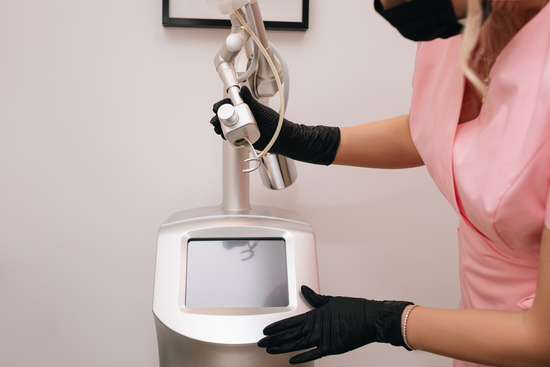LASER CO2

How does CO2 laser resurfacing work?
With CO2 laser resurfacing, pulses of laser light are used. These beams can penetrate deep into the skin’s surface, where skin cells absorb water.
When this happens, the epidermis, or the top layer of skin, is vaporized. As a result, the dermis, or middle layer, gets hot, stimulating the growth of collagen fibers. As the area heals, new, firm & smooth skin replaces old layers.
CO2 laser resurfacing allows the practitioner to target specific problem areas of your skin so the other parts won’t be affected.
How to prepare
Your dermatologist will tell you how to prepare for treatment. Typical preparations include
- avoiding tanning or heavy sun exposure for four weeks before treatment
- not using medications that cause sun sensitivity, such as doxycycline, for three days before treatment
- taking antiviral medicines for a few days before and after treatment if you have a history of herpes or shingles
- quitting smoking for two weeks before and after treatment since tobacco can interfere with healing
The procedure
Here’s what you can expect on the day of your CO2 laser treatment:
- This outpatient procedure generally takes between 30 minutes and 2 hours, depending on the issue being addressed and the area of skin receiving treatment.
- CO2 laser resurfacing does involve some pain. The pain level you experience will depend on the depth and extent of resurfacing, the skill of the dermatologist or surgeon, and your pain tolerance.
- You’ll receive a combination of local anesthetic and a sedative to prevent pain and help you relax. In addition, you may receive general anesthesia for extensive resurfacing so you sleep through the treatment.
- Before the treatment begins, your skin will be thoroughly cleaned, and you’ll receive unique eyewear to protect your eyes from the laser.
- During the treatment, the dermatologist or surgeon will move the laser wand slowly over the area of the skin being treated.
- You may receive an ice pack to apply to the treated area for 15 minutes to prevent swelling.
- Finally, an antibacterial ointment and nonstick dressing will be applied to the treated skin. Leave this on as instructed, usually for 24 hours.
Depending on your need and the laser used, you may need more than one treatment session.
What are the benefits?
CO2 laser resurfacing can treat many unwanted skin appearances, from visible signs of aging and sun damage to scars and skin cancer.
Fine lines and wrinkles
CO2 laser resurfacing can improve the appearance of fine lines and wrinkles. This procedure is particularly effective in cases of:
- crow’s feet, or lines and wrinkles under and around the eyes
- lines and wrinkles on the forehead
- laugh lines, or those appearing around the mouth
It can reduce the appearance of wrinkles immediately and encourages collagen production, which improves health over time.
Sun damaged skin
Exposure to UV may contribute to visible signs of skin aging. That includes:
- wrinkles
- sagging due to decreased elasticity
- rough and uneven skin texture
- liver spots and sunspots
- spider veins
CO2 laser resurfacing can significantly reduce the appearance of deep wrinkles, scars, pore size, and skin tone.
Baggy Eyes
Sagging skin above your upper and lower eyelids can be responsible for what’s known as «baggy» or «hooded eyes.»
CO2 lasers can gently tighten the skin, and they may do other good things, too, like improve the laxity of the eyelids and make it so your eyes don’t look so droopy.
Acne scars
C02 laser treatment can be beneficial in reducing the appearance of acne scars. The laser stimulates collagen production, and this helps smooth out and tighten the wounds.
That’s true. It might not work on all acne scars, but it will improve the skin’s overall condition.
Warts
Most dermatologists use other solutions, like over-the-counter treatments or freezing, for warts. But they may also use lasers on persistent warts that don’t respond to those methods.
Sebaceous hyperplasia
Sebaceous hyperplasia is when sebum gets trapped in an oil gland, making the skin appear as a small bump. These are usually harmless, but they can be removed for cosmetic reasons if you want to.
Safety and side effects
CO2 lasers have been used for a long time and are considered safe, effective, and reliable.
There are many different side effects that CO2 laser resurfacing may cause, depending on your individual needs and characteristics. Some of the most common side effects include:
- some skin discoloration and swelling
- skin that feels raw, similar to a mild sunburn
- itching
- dryness and peeling
- sun sensitivity
If you overdo it with your skin resurfacing, the side effects can make it feel tight, oozy, and blotchy.
What’s the recovery like?
CO2 Laser Resurfacing sessions typically take 1-2 weeks to recover fully. Following your dermatologist’s or surgeon’s post-op instructions will help you heal and lower the risk of complications.
Here’s what you can expect during the recovery process:
- You’ll experience redness, itching, stinging, and peeling when you start using it. However, these symptoms will go away in a few days.
- Your skin may become red, ooze a viscous yellow liquid and eventually necrose.
- After about 5-7 days, your skin will dry and peel. The outer layer may have a pink or pale appearance that will gradually become your skin color. You can expect this process to take about 6-12 months.
Book an Appointment with an Aesthetic Specialist
Book an Appointment with a Dental Care Specialist
Book an Appointment with an Aesthetics Care Specialist
Book an Appointment with a Nutritionist Care Specialist
Book an Appointment with a Cosmetology Care Specialist
Urban Center Building.
Blvd. General Sánchez Taboada 9589 Suite102 1St floor, Zona urbana rio, Tijuana 22010, B.C. México.
